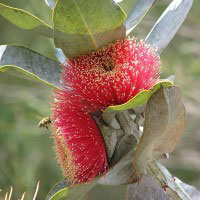| Aug 01, 2013 | |
Nanotechnology researchers create antibacterial gold nanoparticles from eucalyptus leaves |
|
(Nanowerk News) Murdoch University researchers have developed a ‘green’ method to create antibacterial gold nanoparticles for potential use in the medical field with the help of common eucalyptus leaves ("Green biosynthesis of gold nanometre scale plates using the leaf extracts from an indigenous Australian plant Eucalyptus macrocarpa").
 Eucalyptus macrocarpa is giving nano-medicine a boost Dr Gerrard Eddy Poinern, Director of the Murdoch Applied Nanotechnology Research Group (MANRG), said gold nanometre scale particles were on the leading-edge of health innovation. “Gold nanoparticles have proven to be very versatile across a range of treatments, including in the delivery of double-stranded DNA in the emerging gene therapy area,” Dr Poinern said. “They can also be passively accumulated in tumours for thermal treatment therapies, where they are heated to damage and kill cancer cells. “And studies have shown that cancer drugs bonded to the surface of gold nanoparticles can effectively target tumours, improving delivery and minimising treatment durations and the side effects of anticancer drugs.” |
|
| Dr Poinern said, however, that up until recently, the particles’ production had involved expensive chemical and physical processes that often used toxic materials with potential hazards such as environmental toxicity, cytotoxicity and carcinogenicity. | |
| “Thanks to the Eucalyptus macrocarpa, we’re changing that. Our method is water-based, performed at room temperature and without the need for complex equipment and is clean and non-toxic,” he said. | |
| The ‘green’ production of gold nanometre scale particles involves dissolving high purity gold wire into a mixture of nitric and hydrochloric acid to produce gold chloride. | |
| The gold chloride is then mixed with a water-based solution of leaf extracts from the common Eucalyptus macrocarpa and allowed to synthesize at room temperature. | |
| “Not only does this result in the creation of nanometre scale gold prisms, but the wax of the eucalypt leaf extract provides an additional antibacterial and antifungal quality,” Dr Poinern said. | |
| “Since bacterial and fungal species have the ability to develop immunity against commonly used antibiotics over time, our gold nanometre scale particles also stand to be a new tool against antibiotic resistant forms of microorganisms.” | |
| Dr Poinern said the nanometre scale gold particles were tested as antibacterial agents against both E. coli and B. subtilis, producing zone inhibition of 19mm and 16mm respectively. |
| Source: Murdoch University |
